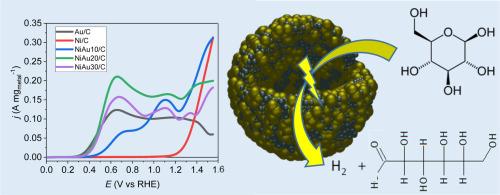当前位置:
X-MOL 学术
›
Electrochim. Acta
›
论文详情
Our official English website, www.x-mol.net, welcomes your
feedback! (Note: you will need to create a separate account there.)
Glucose electrooxidation on carbon supported NiAu electrocatalysts
Electrochimica Acta ( IF 5.5 ) Pub Date : 2024-11-17 , DOI: 10.1016/j.electacta.2024.145367 Weliton Silva Fonseca, Thibault Rafaïdeen, Hamza Kahri, Têko W. Napporn, Christophe Coutanceau
Electrochimica Acta ( IF 5.5 ) Pub Date : 2024-11-17 , DOI: 10.1016/j.electacta.2024.145367 Weliton Silva Fonseca, Thibault Rafaïdeen, Hamza Kahri, Têko W. Napporn, Christophe Coutanceau

|
NiAu/C nanomaterials are synthesised using a wet chemistry method with targeted Au atomic ratios of 10%, 20% and 30%. Physicochemical characterisations indicate that the materials have mean compositions close to the nominal ones but ca. 20 at% Au richer in average than expected (Au ratios of 13.6 at%, 23.1 at% and 35.9 at%, respectively). The NiAu/C materials are composed of Au-rich spherical-like Janus particles of several tenths nm and of a phase of very small Ni-rich nanoparticles and Ni(OH2) clusters. The electrochemical measurements in a 0.1 M NaOH/0.1 M glucose electrolyte indicate that the NiAu20/C catalyst is the most active for the glucose oxidation reaction, leading to a mass activity at +0.6 V vs RHE more than 1.5 times higher than that with a pure Au/C catalyst, although the Au content is almost 5 times lower. The chronoamperometry measurements for 900 s at +0.6 V vs RHE confirm the activity gain with the NiAu20/C catalyst. The electrolysis measurement at a cell voltage of +Z+0.6 V for 6 hours shows that the NiAu20/C catalyst is selective towards the production of gluconic acid, with a faradaic efficiency higher than 100%, indicating the occurrence of a 1-electron reaction with anodic hydrogen coproduction. At +0.8 V, the faradaic efficiency is lower than 100 %, indicating the formation of other products than gluconic acid, but at a very low extent (not detectable by HPLC) guarantying a very high selectivity towards gluconic acid.
中文翻译:

碳负载型 NiAu 电催化剂上的葡萄糖电氧化
NiAu/C 纳米材料采用湿化学方法合成,目标 Au 原子比为 10%、20% 和 30%。物理化学特征表明,这些材料的平均成分接近标称成分,但平均富度比预期高出约 20 at% 的金(金比分别为 13.6 at%、23.1 at% 和 35.9 at%)。NiAu/C 材料由十分之几纳米的富金球形 Janus 颗粒和一个非常小的富镍纳米颗粒和 Ni(OH2) 团簇相组成。在 0.1 M NaOH/0.1 M 葡萄糖电解质中的电化学测量表明,NiAu20/C 催化剂对葡萄糖氧化反应最活跃,导致 +0.6 V 与 RHE 的质量活度比纯 Au/C 催化剂高 1.5 倍以上,尽管 Au 含量几乎低 5 倍。与 RHE 相比,在 +0.6 V 下 900 秒的计时安培测量证实了 NiAu20/C 催化剂的活性增加。在 +Z+0.6 V 的电池电压下进行 6 小时的电解测量表明,NiAu20/C 催化剂对葡萄糖酸的产生具有选择性,法拉第效率高于 100%,表明发生了阳极氢共产的 1 电子反应。在 +0.8 V 电压下,法拉第效率低于 100 %,表明会形成除葡萄糖酸以外的其他产物,但在非常低的范围内(HPLC 无法检测到),保证了对葡萄糖酸的极高选择性。
更新日期:2024-11-18
中文翻译:

碳负载型 NiAu 电催化剂上的葡萄糖电氧化
NiAu/C 纳米材料采用湿化学方法合成,目标 Au 原子比为 10%、20% 和 30%。物理化学特征表明,这些材料的平均成分接近标称成分,但平均富度比预期高出约 20 at% 的金(金比分别为 13.6 at%、23.1 at% 和 35.9 at%)。NiAu/C 材料由十分之几纳米的富金球形 Janus 颗粒和一个非常小的富镍纳米颗粒和 Ni(OH2) 团簇相组成。在 0.1 M NaOH/0.1 M 葡萄糖电解质中的电化学测量表明,NiAu20/C 催化剂对葡萄糖氧化反应最活跃,导致 +0.6 V 与 RHE 的质量活度比纯 Au/C 催化剂高 1.5 倍以上,尽管 Au 含量几乎低 5 倍。与 RHE 相比,在 +0.6 V 下 900 秒的计时安培测量证实了 NiAu20/C 催化剂的活性增加。在 +Z+0.6 V 的电池电压下进行 6 小时的电解测量表明,NiAu20/C 催化剂对葡萄糖酸的产生具有选择性,法拉第效率高于 100%,表明发生了阳极氢共产的 1 电子反应。在 +0.8 V 电压下,法拉第效率低于 100 %,表明会形成除葡萄糖酸以外的其他产物,但在非常低的范围内(HPLC 无法检测到),保证了对葡萄糖酸的极高选择性。


















































 京公网安备 11010802027423号
京公网安备 11010802027423号